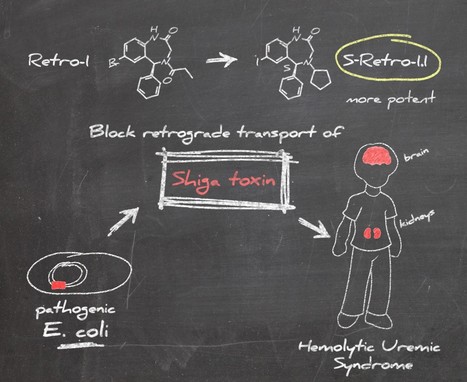Shiga toxins produced by certain bacteria (Shigella dysenteriae and some strains of Escherichia coli) can lead to foodborne illness, especially in young children, sometimes resulting in bloody diarrhea and, in the most severe cases, hemolytic uremic syndrome (HUS). Following a biological screen (cell activity test) carried out on the SCBM small molecule screening platform, Retro-1, a compound from the benzodiazepine family, showed good efficacy (EC50 = 6 µM) against Shiga toxin. Retro-1 inhibits the toxin by decreasing its intracellular transport by the retrograde route from early endosomes to the Golgi apparatus, preventing access to the latter, a necessary step for the release of its toxic subunit in the cytoplasm of the cells (Stechmann et al. Cell 2010).
In this study, researchers undertook an analysis of the structure-activity relationship of Retro-1, in order to increase its toxin-inhibitory effect. As a result, they obtained new, much more active benzodiazepinones, including Retro-1.1, which has an EC50 of 90 nM in cell protection tests, approximately 70 times higher than its parent Retro-1. They have also shown that this compound blocks the retrograde trafficking of Shiga toxin and experiments are underway to decipher its mode of action and identify its cellular target(s).

© JC Cintrat, D Gillet, J Barbier/CEA
Knowing that Retro-1 behaves like Retro-2 by blocking intracellular trafficking of the toxin, it would be interesting to test optimized Retro-1 analogues, such as Retro-1.1, against various pathogens, especially viruses such as poxviruses, cytomegalovirus and enterovirus 71, for which Retro-2 derivatives have been shown to be effective.
Contact : jean-christophe.cintrat@cea.fr or daniel.gillet@cea.fr